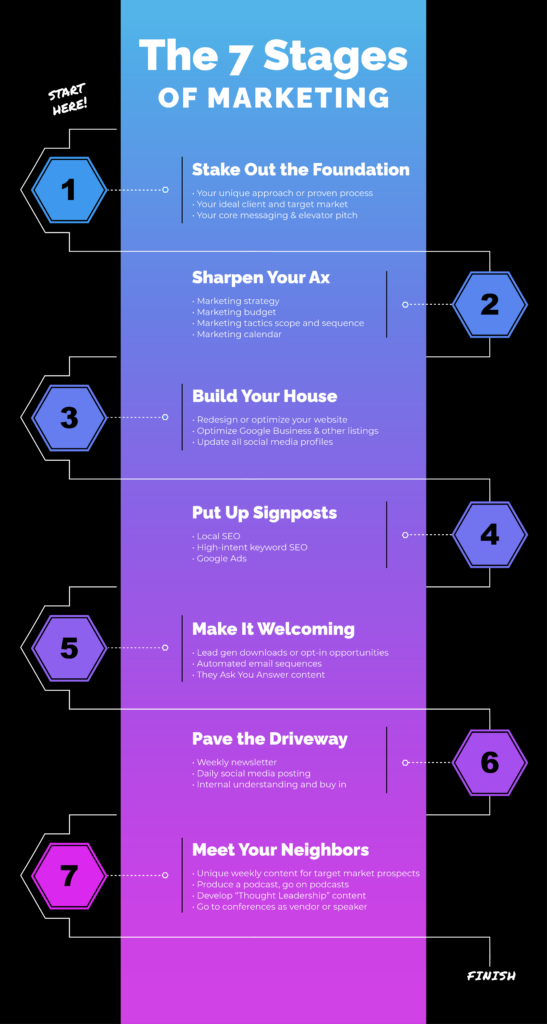The 7 Stages of Marketing for Accounting Firms: Stake out Your Foundation
Marketing for accounting firms is just like building a house. You need to follow a plan, keep it simple, and build it step by step. We believe that philosophy so much that Matt, our founder, helped codify it into seven steps for anyone to follow. Over the course of the next several weeks, we’ll be fleshing out some of the ideas listed in this infographic and how they can be applied to the marketing plan for your accounting firm.

Step one might seem a little facile, but trust us — just like a house, you want to make sure that your foundation is solid before you build the rest of it out. To do this takes some careful thought and planning. We’ve broken it down into four key documents. Each will help you understand your own positioning, who your clients are, how you help them, and how to get them to understand the ways you help.
Step One: Stake Out the Foundation
The first step to effective marketing is getting clear about yourself. What do you offer? How are you positioned in the market compared to your competitors? Who is your target market? What is your core sales message?
There are four documents you need to develop. Additionally, we’ve listed an internal philosophy as you’ll need to generate internal buy-in from your team.
Your Checklist for Step One
- Positioning Statement
- Ideal Client Profile
- Brandscript
- Elevator Pitch
- (additionally) Internal understanding and buy-in from your team
How to Create a Positioning Statement for Accounting Firms
A 2-3 paragraph document that describes your unique selling proposition, at what point you typically enter your customer’s journey, the difference between you and your main competitors, which markets are good and bad fits for your services. Again, you don’t need to overthink this, but your positioning statement will be the document from which all your other marketing ideas will flow. Try to be thoughtful and thorough, but don’t let it drag you down. Commit it to paper!
How to Create Your Ideal Customer Profile for Accounting Firms
You’ll need a 1-page document that describes a specific, ideal customer. The goal is to describe a real person. It should include demographic information (age, education, family), firmographic information (headcount and revenue of their company), and psychographic information (their values, desires, and goals).
Name this person and pick out a stock photo to represent them. You should create individual profiles for each market if you have multiple target customers.
How to Create a BrandScript for Accounting Firms
We recommend using the StoryBrand 7-part Framework to create a 1-page messaging document to serve as the foundational “message” that you want to be communicating to your market through any/all marketing efforts.
You can reference this document as your create individual emails, posts, videos, to expand on this messaging, while keeping everyone in alignment with one overarching theme for your marketing.
How to Create an Elevator Pitch for Accouting Firms
A 3-sentence “pitch” for your company using the Problem > Solution > Results format.
Don’t overthink this. It SHOULD be simple. This is your default answer when anyone asks “what do you do?” and can be used in social media bios, email signatures, printed flyers, directory listings, and anywhere you need a plug-and-play description of your company.
How to Create Internal Buy-In for Your Team
There is no point, as the marketing person in your firm, in doing this work if your team isn’t bought in. You must “sell” your positioning and messaging to your team and get everyone on the same page. This is especially true for the sales team, department leaders, and client-facing team members.
If your messaging makes a promise that your team can’t deliver on (or that they don’t agree they CAN deliver on), you’re in big trouble. Take the time to get everyone on board. What does that look like? Well, training for one — but it’s also a dialogue. What does your team see within this framework that makes sense? Do they have questions? Being open and honest during this process is CRUCIAL for getting your team to buy-in to this philosophy.
Next week? We’ll talk about how you’ll sharpen your axe (metaphorically speaking) to better target your customers. Trust us, you won’t want to miss it.


